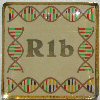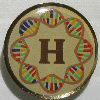

Haplotype (HT) vs. Haplogroup (HG)
Learn more about Genetic Genealogy.
See my "Genetics & Genealogy - An Introduction" report. It's free.
Also check out my Genetic Genealogy DNA Testing Dictionary
"What's Your Sign?" is passe. Now it's "What's Your Haplogroup?"
Back to DNA Info & Resources Page.